THE highest mountain in Spain soars 11,400ft above a wide valley of pine woods, olive groves and baked earth in a great, swelling blueness that almost fades into the heat haze. Its flanks are dotted with white-walled Moorish villages and rudimentary shepherds’ huts. Its summit is a gentle curve, a little higher than the gentle curves surrounding it. Its name is Mulhacen – and it is the central hub of the Sierra Nevada mountain range.
A few days ago the Sierra Nevada was, to me, little more than a name and a series of imagined peaks. But I have sketched my mental picture anew and filled some blank canvas with colours – mainly earthy browns, ochres, and dusty greens.
I have learnt that the farms and villages of the Sierra Nevada are fed by an intricate irrigation system that dates back to the time of the Moors – and possibly the Romans – bringing foaming water from the snowfields to the valleys. I have seen ibex skipping nimbly up impossibly steep rock faces. I have almost run over a wild boar. I have been told stories of the Spanish Civil War and heard of fascist atrocities in Orgiva – the town where my wife and I are staying.
Slowly, an imagined land is changing into a very real land with lonely tracks, wild figs, a violent past, hot sun, and winds scented with thyme, rosemary and wild lavender.
The mountain shapes are becoming familiar. Already I can recognise Mulhacen amid the jumble of peaks, and the sloping shelf of Veleta – its near neighbour – the third-highest mountain in Spain. The most familiar mountain, though, is the one up which I am struggling in the late morning sun. This path has been walked by Greeks, Phoenicians, Romans, Moors and Christians. It zigzags up the northern flank of Sierra de Lujar to the ancient mines of San José, and purportedly continues to the summit.
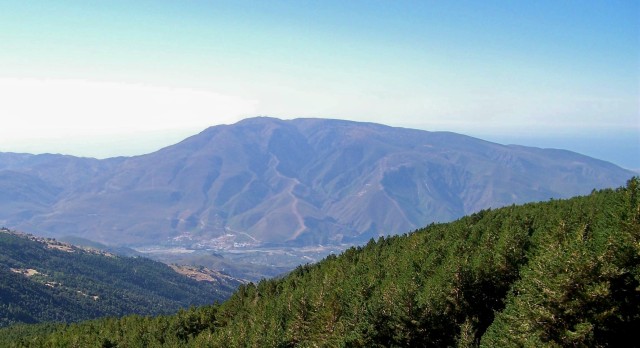 Lujar is to Orgiva what Skiddaw is to Keswick. It’s a great, rolling brute of a mountain that dominates the view to the south. Compared with its northerly neighbours it is somewhat lacking in stature – a mere 1,851 metres (6,072ft) – but it possesses the mystical qualities and pleasing proportions of a mountain that stands in isolation. Lujar has attitude; it has character; it has a presence that demands attention. It also has a fantastic wealth of abandoned mineworkings high on its northern flank, to which I am drawn like a sad English moth to a guttering Spanish flame. And I am not alone.
Lujar is to Orgiva what Skiddaw is to Keswick. It’s a great, rolling brute of a mountain that dominates the view to the south. Compared with its northerly neighbours it is somewhat lacking in stature – a mere 1,851 metres (6,072ft) – but it possesses the mystical qualities and pleasing proportions of a mountain that stands in isolation. Lujar has attitude; it has character; it has a presence that demands attention. It also has a fantastic wealth of abandoned mineworkings high on its northern flank, to which I am drawn like a sad English moth to a guttering Spanish flame. And I am not alone.
 Let me introduce you to Bruce Mac Nally, erstwhile farm manager, truck salesman, sheep shearer, double-glazing entrepreneur, irrigation technician and taxi driver. Bruce is the chap in the pictures wearing a sensible hat, sensible light-weight boots, sensible clothes and clutching a sensible Spanish walking staff. I’m the bloke you can’t see because I’m panting ten paces behind with the camera and clad in gear more suited to the Cairngorms in early spring. Bruce and his wife, Brenda, own La Luz, which my wife and I are renting. It’s a pleasant casita on a plantation of olives, oranges, pomegranates, figs and almonds, and sheltered by a eucalyptus wood on the outskirts of Orgiva. Bruce is leading the way because he has the map, he’s been up here before, and he’s moving faster than me.
Let me introduce you to Bruce Mac Nally, erstwhile farm manager, truck salesman, sheep shearer, double-glazing entrepreneur, irrigation technician and taxi driver. Bruce is the chap in the pictures wearing a sensible hat, sensible light-weight boots, sensible clothes and clutching a sensible Spanish walking staff. I’m the bloke you can’t see because I’m panting ten paces behind with the camera and clad in gear more suited to the Cairngorms in early spring. Bruce and his wife, Brenda, own La Luz, which my wife and I are renting. It’s a pleasant casita on a plantation of olives, oranges, pomegranates, figs and almonds, and sheltered by a eucalyptus wood on the outskirts of Orgiva. Bruce is leading the way because he has the map, he’s been up here before, and he’s moving faster than me.

The miners' path zigzags up Lujar's northern flank, climbing from the valley to the ancient Minas de San José through scrub and wild herbs
The zigzagging miners’ track is hard and dusty work though refreshingly rewarding, giving fine views over Orgiva and the Moorish villages of Pampaneira, Bubion and Capileira, high on the slopes of Mulhacen. The mines were first exploited by the Greeks and then the Phoenicians, so a good few foreign feet have stumbled up this slope – most of them to engage in hard and dangerous labour rather than admire the view.
On the crown of the ridge, after passing the mouths of several tunnels, we arrive at the Minas de San José. If anyone wants to know the way to San José, I can point them in the right direction and tell them it’s a long, hard and sweaty one – and requires at least two litres of water to counter the effects of dehydration.
We sit in the shade and eat tomatoes. Bruce tells me Sierra de Lujar was held by the Republicans for the entire Spanish Civil War. They used their vantage point to rain shells and bullets down on the fascists. Only when their war ended in defeat did the defenders melt into the vastness of Lujar’s flanks and slip into obscurity. Orgiva was evacuated for a time during the conflict. And one of the arches of the Seven-Eye Bridge – which spans the Rio Guadalfeo – was blown up (I learn later in a TV documentary made by Michael Portillo that hundreds of local people were butchered by the fascists, their bodies dumped in a ravine between Orgiva and Lanjaron).
The original Lujar miners appear to have been seeking lead and copper, but when the mines were in their final years, fluorite was the mineral that paid the wages. The venture was abandoned in recent times – the 1980s or early 1990s. There are more than 70km of tunnels, many gaping adits, a number of ruined buildings through which we rummage, and plenty of interesting features to photograph and examine.
 There is a certain breed of mildly eccentric Englishman that likes to clatter about in the ruins of vanished industries while the midday sun bakes the stones, and Bruce and I appear to slip into this category with little effort. In a derelict building we sift through boxes of drill cores; we drop stones down vertical shafts to gauge their depth; we spend ten minutes perched on the edge of a precipice discussing the engineering principles behind a long-abandoned aerial ropeway; we scratch at the spoil heaps for traces of mineral. Boys are good at this sort of stuff.
There is a certain breed of mildly eccentric Englishman that likes to clatter about in the ruins of vanished industries while the midday sun bakes the stones, and Bruce and I appear to slip into this category with little effort. In a derelict building we sift through boxes of drill cores; we drop stones down vertical shafts to gauge their depth; we spend ten minutes perched on the edge of a precipice discussing the engineering principles behind a long-abandoned aerial ropeway; we scratch at the spoil heaps for traces of mineral. Boys are good at this sort of stuff.

Orgiva from the ruins of a mine building, with the peaks of Cerro de Caballo (far left), Pico del Tajo de los Machos, and, just discenible, Veleta (far right)
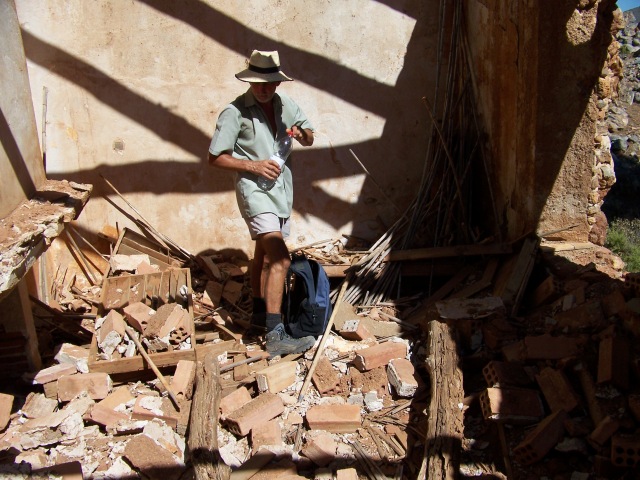
 The last tunnel we stumble upon has a “Danger Keep Out” notice bolted to the rock and is gated. But the gates are not locked, only fastened with wire. Naturally, we get our torches out and wander inside. And what joy of joys: a blast of subterranean air so strong it makes our shirts and shorts flap – a sure sign the workings are of considerable extent and have links to other horizons.
The last tunnel we stumble upon has a “Danger Keep Out” notice bolted to the rock and is gated. But the gates are not locked, only fastened with wire. Naturally, we get our torches out and wander inside. And what joy of joys: a blast of subterranean air so strong it makes our shirts and shorts flap – a sure sign the workings are of considerable extent and have links to other horizons.
Twenty years ago, with the proper equipment and a gang of friends, I would have spent a happy couple of days rumbling about in these workings. This is mining heaven. It is also a very disorientating and dangerous place, so after half an hour we retrace our steps to daylight and examine a lump of veinstone I have liberated. Underground, in the beams of our torches, it glittered like black silver. Some of the mineral content has the appearance of specularite or sphalerite. I have no doubt it is neither.
As we scrabble about in the dust looking for more minerals, the realisation dawns that we have left it too late to strike out for the summit, and a second mine – Penarroya – a further two kilometres up the ridge. So we sit in the sun and eat more tomatoes – a local variety with a name I forget, but which translates as “bull’s balls”.
A well-engineered dirt road spirals down the ridge from Minas de San José to the welcome shade of Penon del Fraile, a rocky ravine that will take us back to Orgiva. We pass another mine where the buildings have been renovated and interpretation boards erected, and pluck blue figs from a tree at the tunnel entrance. An aerial ropeway ran from this place to the processing plant at Los Tablona, and some of the pylons still stand on the neighbouring flank of Lujar. We sit down again and eat figs this time, discussing the merits of aerial ropeways and gravity inclines.
 And from the shade of the fig tree I gaze out across the valley to the slopes of the Sierra Nevada, where Mulhacen and Veleta dominate the horizon. And I think: dusty boots; tired legs; sweaty shirt; wild figs; hot sun; ancient tracks; and blue, blue mountains – what else can a man want? Not much . . .
And from the shade of the fig tree I gaze out across the valley to the slopes of the Sierra Nevada, where Mulhacen and Veleta dominate the horizon. And I think: dusty boots; tired legs; sweaty shirt; wild figs; hot sun; ancient tracks; and blue, blue mountains – what else can a man want? Not much . . .
. . . Perhaps a cool beer.
NOTES:
- FOR details of Casita La Luz, the perfect base from which to explore the Sierra Nevada and Alpujarras, click here.


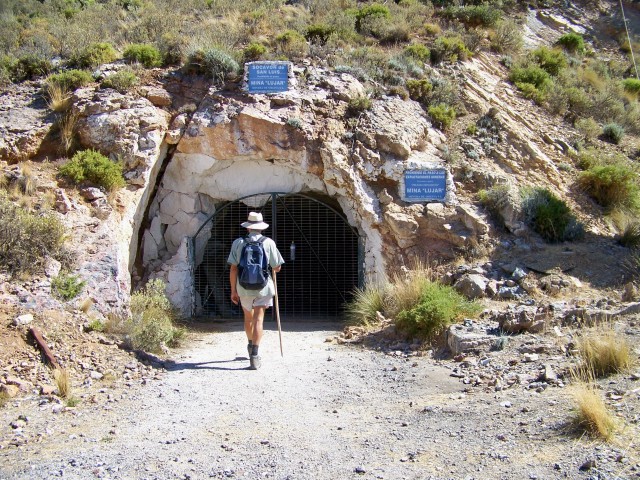












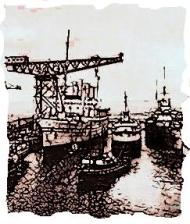
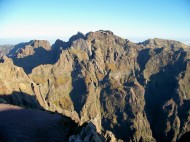
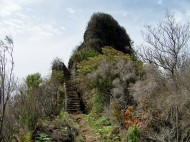
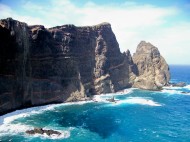




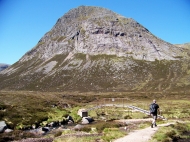



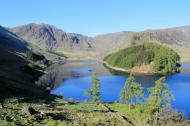


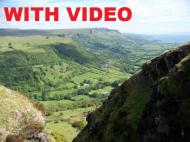
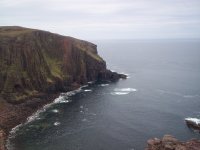
Hi Alen,
My brother has just arrived today with his family for their first ever visit to la Luz.
Earlier I described to them our day climbing up to the mine. They have just all gone to bed and I thought I would google my name and to my amazement found this story. What a wonderful excursion it was, I think it was the best days walking I have had around here and thank you for your company, conversation and your brilliant portrayal of the day . Sincerely, Bruce
Thanks for that Bruce. See you again soon, I hope. All the best.